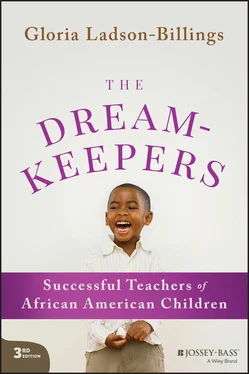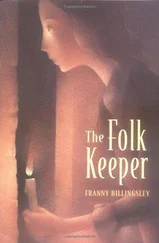Tables 3.1, 4.1, and 5.1 are reprinted from Ladson-Billings, G., “Like Lightning in a Bottle: Attempting to Capture the Pedagogical Excellence of Successful Teachers of Black Students,” QSE, 3 (4), 335–344. Reprinted with permission.
The epigraph on p. 127 is from On the Pulse of Morning . Reprinted with permission of Random House, Inc.
Cover design by Paula Schlosser.
Front cover photograph © Nita Winter, Corte Madera, California.
Jossey-Bass books and products are available through most bookstores. To contact Jossey-Bass directly call our Customer Care Department within the U.S. at 800-956-7739, outside the U.S. at 317-572-3986, or fax 317-572-4002.
Jossey-Bass also publishes its books in a variety of electronic formats. Some content that appears in print may not be available in electronic books.
Library of Congress Cataloging-in-Publication Data is Available:
ISBN 9781119791935 (paperback)
ISBN 9781119791959 (ePDF)
ISBN 9781119791942 (ePub)
COVER DESIGN: PAUL MCCARTHY
COVER ART: © GETTY IMAGES / DIGITAL VISION
FOREWORD TO THE THIRD EDITION
I am writing this foreword in the midst of the Novel Corona Virus—COVID-19—where cases are spiking in the upper Midwest and West. In many of the conversations I have been having about what impact this pandemic is having on schools in the US I am compelled to argue that COVID-19 is but one of the pandemics we are facing at this moment. I would argue that we are actually in the midst of four pandemics, COVID-19, which we know of, anti-Black racism, economic collapse, and climate catastrophe. All four of these pandemics are impacting our students, their families, and their communities.
The COVID-19 pandemic grabbed all of the headlines when the virus traveled from Wuhan, China, to Italy and other parts of Europe to the United States. As of this writing the US has had more cases of COVID-19 (9 million) than any country in the world with more than 228,000 deaths. This pandemic has caused many of us to work strictly from home, curtailed in-person schooling at both pre-collegiate and collegiate levels, slowed airline travel to a fraction of what we normally expect, and stopped millions of small businesses (restaurants, bars, barbers, beauticians, etc.) from operating in their typical fashion. This is something the nation has not seen in more than 100 years, since the 1918 flu pandemic. Many parents have been forced to serve as their children’s teachers while concurrently trying to show up virtually for their own jobs. COVID-19 revealed the incredible disparities that exist between White, middle income students and Black, Latinx, Indigenous, and immigrant poor children. While we were all in the same storm, it became apparent that we were not all in the same boat. Some families rode out COVID-19 on a luxury liner while others were barely holding on to a raft.
On May 25, 2020, Minneapolis resident George Floyd was apprehended by a police officer and shortly after lay on the ground with a police officer’s knee on his neck. Despite pleading with the officer that he could not breathe, Mr. Floyd was subjected to 8 minutes and 46 seconds of that officer’s knee on his neck where he expired. In addition to the officer whose knee was on Mr. Floyd’s neck there were three other officers on the scene who did nothing to aid him despite audible cries from an astonished public to help him. Mr. Floyd’s murder sparked unrest and uprisings throughout the nation and around the world. People began to protest racism not only in cities and towns in the US but also in the UK, France, and Canada. Confronting anti-Black racism became a worldwide cause. It represented a second pandemic.
The third pandemic is the coming economic collapse. It is trailing COVID-19 because job loss and skyrocketing medical costs were directly related to the coronavirus pandemic. Families across the nation are trembling in anticipation of evictions and foreclosures. Parents are standing in food lines to supplement what they are able to put on the table. Families are unable to pay utility bills and car notes. About 800,000 women have left the workforce compared to 78,000 men. Many of these women were in the prime working ages of 35 to 44.
The fourth pandemic is climate catastrophe. Although there are those who deny climate change, those who experienced the horrendous West Coast wildfires or the spate of hurricanes that entered the Gulf Coast region (so many that the National Weather Service went through the traditional alphabet and started in on the Greek alphabet), know that the climate is definitely changing. There are more days with temperatures above 90 degrees, more days with stagnant air, longer mosquito seasons, more coastline erosion, and lower mountain snow packs across the country. Climate change is very real for most people.
This litany of pandemics may sound a lot like gloom and doom, but I actually have a bit of hope supplied by Indian novelist, Arundhati Roy, who wrote an essay entitled, “The Pandemic Is a Portal” (see https://www.ft.com/content/10d8f5e8-74eb-11ea-95fe-fcd274e920ca). According to Roy, the pandemic gives us an opportunity to step into a new world leaving all of our old “carcasses, prejudices, avarice, old ideas” and other things behind. She argues we can carry “little luggage” and walk “lightly” into a new world ready to “fight for it.” What a refreshing way to approach this full stop we have been asked to make as a result of the pandemic and reset our educational agenda.
What might a full stop and reset look like? I have argued that what our schools need as a result of the pandemic pause is a “hard reset.” I draw the notion of a hard reset from mobile technologies. While cell phones are ubiquitous—we all have them—they are also prone to fail from time to time. We may turn them off and start them again to see if that fixes our problem. We may remove and then replace the SIM card. We may remove and replace the battery. Sometimes we go online and search for tech support groups. If none of those things work, we may reluctantly head to the mobile device store where a technician alerts us that we need to do a “hard reset.” Those dreaded words mean that if we have not already backed up all of our information, we are going to get a mobile device returned to us minus our pictures and minus our contacts. It will look a lot like it looked when we first received it from the factory. We will need to start over. That is what I believe education through the portal, on the other side of the pandemic, should look like. We will need to reset so we can restart.
Unfortunately, far too many people clammer for school to “get back to normal.” The problem I have with “normal” is that “normal” was where the problems resided. Normal was having Black and Latinx students in the lowest reading groups and lowest tracks in mathematics, English, science, etc. Normal was having Black and Latinx students over-identified for special needs. Normal was having Black and Latinx students disproportionately suspended, expelled, and sanctioned. Normal was Black and Latinx students excluded from Gifted and Talented Education, honors courses, and Advanced Placement classes. Getting back to “normal” is not the place we need to be.
As the chief proponent of “culturally relevant pedagogy” I have had the opportunity to look carefully at what shortcomings of culturally relevant pedagogy have been made evident over these past 30 years. 1 The primary shortcoming is that the pedagogy I observed failed to incorporate the notion of youth culture. While the teachers I observed did an excellent job leveraging students’ home cultures—their first languages, customs, traditions, etc.—they did not factor in the impact of youth culture and its influence on US popular culture. I believe the primary reason for not including youth culture was an artifact of the teachers being teachers of elementary-aged students. Although elementary students consume youth culture through their use of language, adoption of fashion and style, and affection for popular music, they are not producers of youth culture. Had the study been done in secondary classrooms I am certain I would have seen more deliberate deployment of youth culture.
Читать дальше












